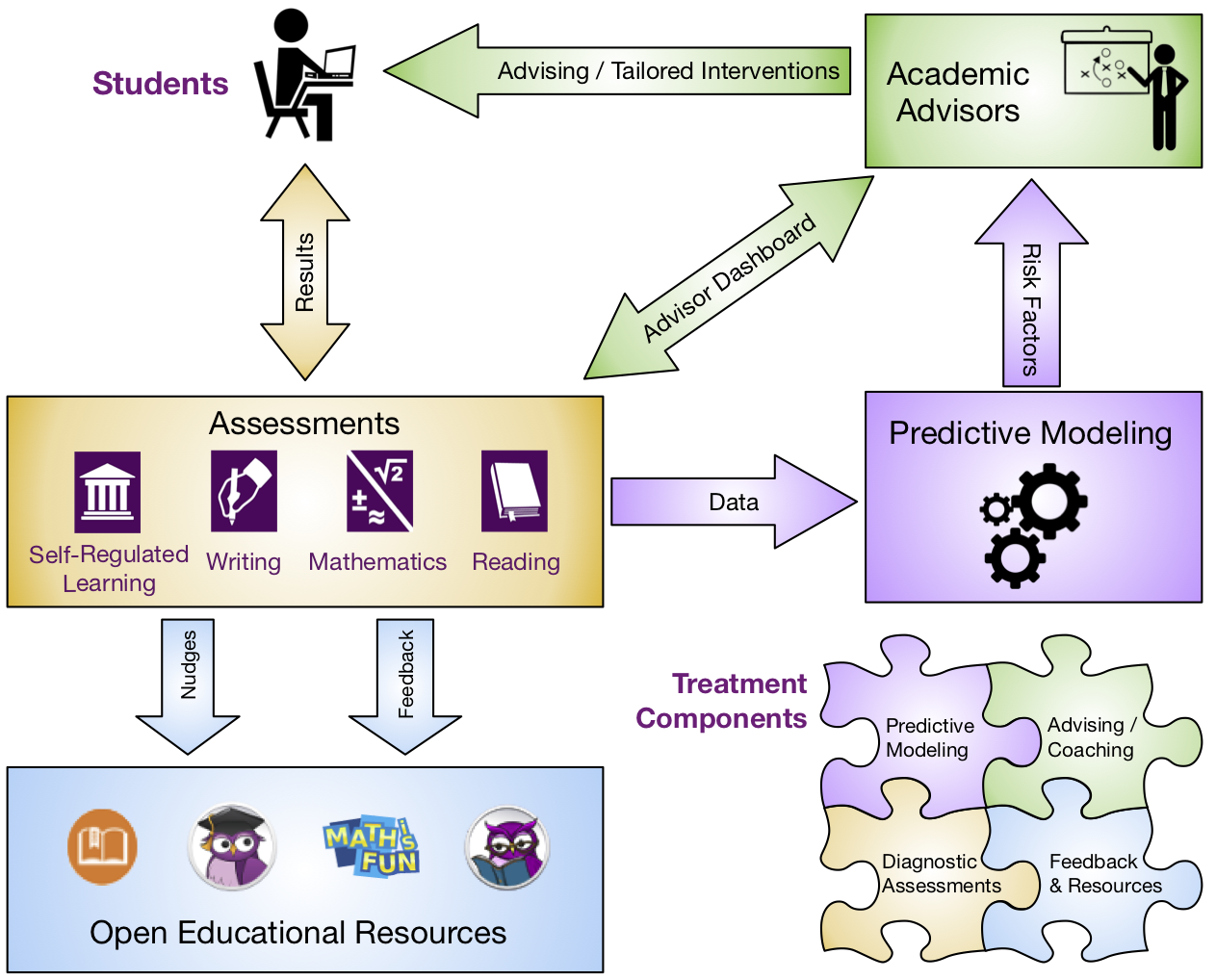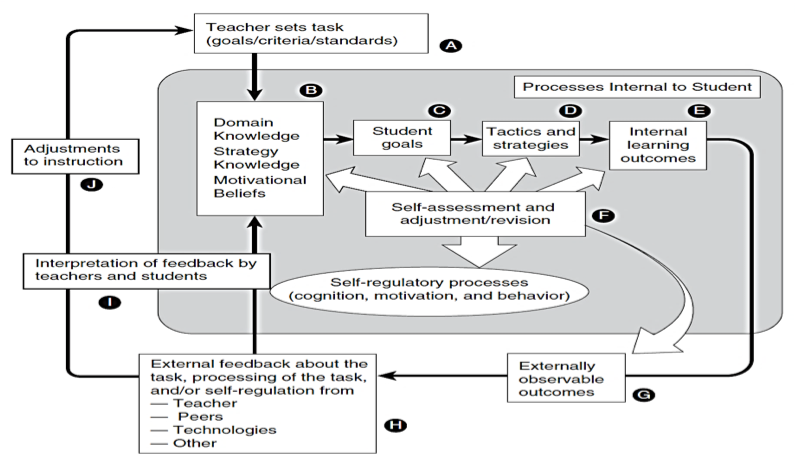The Diagnostic Assessment and Achievement of College Skills (DAACS) is funded by the Department of Education in the Fund for the Improvement of Postsecondary Education First in the World grant program. Excelsior College, Western Governors University, University at Albany, and Rutgers University have been working in partnership to develop and research the impact of DAACS on newly enrolled college students.
DAACS is a suite of technological and social support to optimize student learning. It provides personalized feedback about students’ strengths and weaknesses in terms of key academic (reading, writing, and mathematics) and self-regulated learning skills, linking them to resources to help them be successful students. DAACS is an open source project and institutions are free to use and adapt DAACS for the specific needs of their students. Please contact us for more information.

Project Personnel
Project Directors
Jason Bryer, Ph.D., CUNY School of Professional StudiesHeidi Andrade, Ed.D., University at Albany
Timothy Cleary, Ph.D., Rutgers University
Project Manager & Data Analyst
Angela Lui, Ph.D.Research Associate
David Franklin, Ph.D.Evaluators
IES Grant
Susanne Harnett, Ph.D., Metis AssociatesBrian Yates, Ph.D.,
American University
FIPSE Grant
Amy Gurmuth, Ph.D., EvalWorksBarbara Storandt, M.S., Alta Solutions
Advisory Committee
Current
Diana Akhmedjanova, Ph.D.Virginia Clinton-Lisell, Ph.D.,
University of North Dakota
Kimberly Colvin, Ph.D.,
University at Albany
Abbe Herzig, Ph.D.,
American Mathematical Society
Nathalia Holtzman, Ph.D., CUNY Queens College
Darragh McNally, Ph.D.,
University at Maryland Global Campus
Robert Yagelski, Ph.D.,
University at Albany
Former
Glenn Braddock, Ph.D.,Siena College
Francesco Crocco, Ph.D.,
Excelsior College
Lisa Daniels, Ph.D.,
Excelsior College
Anastasia Kitsantas, Ph.D.,
George Mason University
Jason Levin, MBA,
Western Governors University
Ronald Dugan, Ph.D.,
The College of Saint Rose
Phil Winne, Ph.D.,
Simon Fraser University
Other Personnel
University at Albany
Oxana RoscaElie Yu
Guher Gorgun, M.S.
Kara Hogan, Ph.D.
Fusun Sahin, Ph.D.
Rutgers
Erica Pawlo, Psy.D.Bracha Schnaidman, Psy.D.
Nikki Schreihofer, M.A.
Jackie Slemp
Devora Panish
Amanda Austin
Jamal Waire
Tom Gambino
Excelsior College
Jeanne Mannarino, M.A.Jane Weyers
Bethany de Barros
Patti Croop
Brian McCaffery
Western Governors University
Chelsea Barnett, M.Ed.Jessica Stokes, M.S.
Why DAACS? Why Now?
DAACS provides institutions with an alternative, cost effective approach to traditional placement exams and remedial education. Although developed in an online learning environment, personalized feedback regarding college preparation is equally relevant to students studying in a traditional classroom environment.
The inclusion of both academic (i.e. reading, writing, and mathematics) and non-academic (i.e. academic self-regulation, metacognition, motivation, and learning strategies) assessments provides a more complete picture of the students’ abilities. Moreover, this allows for targeted interventions based upon each individual student’s needs.
For academic self-regulation students are provided strategies that research has shown to be most effective for their particular learning and self-regulation style. For instance, students who score high in extrinsic motivation would be provided different feedback and strategies than those who score high in intrinsic motivation.
| Traditional Placement Exam and Remediation | DAACS Innovations |
| For-profit examinations with a per-student cost | An open access tool with no per student fee. |
| Feedback to students is a pass/fail score. Information about items after the assessment are not generally available. | Formative feedback with links to support services, feedback explaining incorrect items, and information for relearning content. |
| Scores may be imported into a student’s record. | Detailed data informs academic advisement, outreach to special populations, recommended learning and support services. Detailed data integrated into predictive analytics. |
| Academic preparedness only in reading, writing, and mathematics addressed | Academic and non-academic preparedness addressed including SRL skills, mathematics, and text anxiety. DAACS is extendible to include other domains as determined by institutions (e.g. science, computer literacy). |
| Credit-bearing study delayed | Early credit-bearing study encouraged utilizing relevant academic support in parallel with for-credit courses. |
| Students pay for courses not leading to credential, financial aid exhausted prior to degree completion | Financial aid is applied to program requirements. |
By capturing both academic and non-academic student data, DAACS has been shown to substantially increase the efficacy of predictive models, allowing institutions to more accurately identify at-risk students and provide targeted outreach.
Components of the DAACS intervention
DAACS has four major components: 1) Valid and reliable diagnostic assessments of students’ readiness for college in terms of self-regulated learning, reading, writing, and mathematics; 2) feedback, strategies, and links to open educational resources (OERs) that help students address deficiencies; 3) predictive models that identify students at risk, as well as the specific risk factors; and 4) information that enables academic advisors to help students address deficiencies identified by the assessments.
DAACS is a valid and reliable measure of college readiness
DAACS assesses students in four key domains:
- Self-regulated learning - This newly developed 47 item scale includes subdomains of metacognition, strategies, and motivation.
- Writing - The writing assessment asks students to summarize and identify SRL skills they will utilize as a college student. Students receive feedback on their writing in nine criteria. Essays are machine scored using the LightSide software providing students with feedback within one minute.
- Reading - Items and passages from past New York State Regents examinations were selected. Students then receive feedback at the subdomain and item level.
- Mathematics - Items from past New York State Regents and Massachusetts Comprehensive Assessment System were selected. Students receive feedback at the subdomain and item level.
However, DAACS is extensible so that institutions can exclude domains or include additional assessments as appropriate. DAACS is not meant to place students nor to measure their growth.
DAACS links students to open educational resources (OERs) including the DAACS SRL Lab, Excelsior’s Online Writing Lab, Reading Comprehension Lab, and Math is Fun deemed to be most relevant based upon the student’s individual results.
How does DAACS work?
DAACS returns control over progress toward a degree to the student. Students assess their abilities over the course of 90-120 minutes, a time commitment comparable to current placement exams, and will receive in return a wealth of personalized information reflecting their item responses. Completed as part of the orientation to college, students recognize the helpful, rather than threatening, nature of the questions. The detailed and actionable feedback strengthen the relationship between student and advisor and help faculty provide more individualized and targeted instruction to ensure a successful transition to college. This intervention was based on the Model of Assessment as the Regulation of Learning (Andrade, 2013; see Figure below). This model emphasizes the student as the key player in all feedback processes, including regulating and monitoring progress toward desired goals, as well as interpreting external feedback from teachers, peers, or technology.


